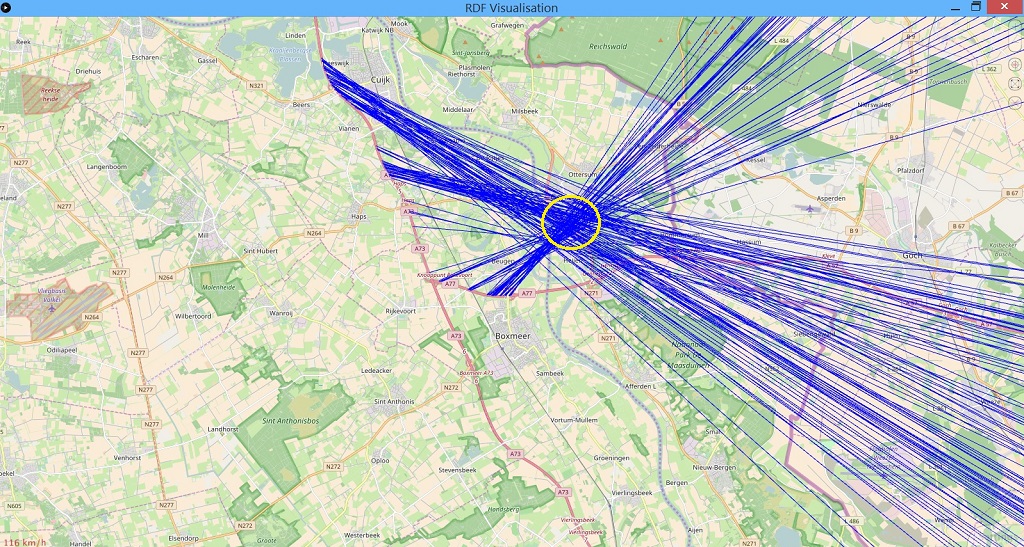Mapping programs for Radio Direction Finding
MapApp:
In the past few years I developed the PA8W MapApp for Android, to enable users to plot their RDF bearings on a map.
A phone or a tablet that runs MapApp gets its bearings from the RDF41/42/43 using a Bluetooth connection. It has a lot of features including bearing exchange with co-hunting teams.
And it is totally free for non-commercial use!
The download and all information can be found here: http://www.paluidsprekers.nl/pa8w/MapApp.html
_______________________________________________
RDF-Mapper:
In the summer of 2016 I called for help in order to create a mapping program for RDF work. A New Zealand wizard Jonathan Musther helped me out; this genius developed just the right tool for me.
Recently he developed a new version of the RDF mapper that can display plus upload its bearings and at the same time download and display the bearings of multiple remote mobile and fixed stations.
The microprocessor based Doppler RDF (PA8W RDF-41/42/43) automatically exports the very best bearings it calculates. This data is sent over a simple USB cable to a laptop or computer, running the RDF mapper program.
The RDF mapper needs no installation, just throw it somewhere on your computer and execute it. Jonathan offers the program for approx. 24,- euro.
He also offers to customize it for a very modest price.
A few RDF41/42/43 radio direction finders, linked together via Jonathan’s RDF Mapper make an affordable but yet extremely capable radio direction finding system.
Link to RDF Mapper
Here’s is how the setup works:
1, Connect the working RDF41/42/43 with its USB output to a USB port of your computer.
2, Run the RDF Mapper program, and select the correct serial port and 9600 Baud for the RDF. If your computer doesn’t yet have a USB driver for the CH340 USB controller of the RDF41 you can download it here: CH340 driver
3, Connect a GPS mouse to your computer, and select the right serial port and baud rate.
(Generally a GPS mouse runs at 4800 Baud.)
Leave the USE MANUAL INPUT box unchecked.
Now the program calculates your driving direction and as soon as you drive faster than the set minimum speed,
bearings will be displayed as soon as the RDF41 thinks they are good enough for display.
4, For fixed applications no GPS is needed, just check the USE MANUAL INPUT box and set the heading
(or the RDF41’s calibration) so that the bearing lines point into the correct direction of a known test signal.
You will have to manually set your location by clicking on the map.
As mentioned, the RDF Mapper can upload your bearings and download bearings from other RDF stations to present them on your screen, using Jonathan’s server.
These options are highly self-explanatory but Jonathan or I will help you out if you encounter any problem.
And if you would like to use your own server Jonathan will offer you all that’s necessary to do so for a very modest price.
Some test results on UHF (424MHz) are shown in the below pictures:

The red arrow is me being a mobile RDF station.
Additionally, you see two blue remote stations being downloaded and displayed.
Obviously, the transmitter is likely to be very close to or even in the crossing area of all bearing lines.
Here, the mobile is closing in on the transmitter, with the assisting remote stations one being about 3 degrees off and the other being spot on.
The black star is the actual location of the tracked transmitter.

Just as the previous RDF Visualisation, the new RDF mapper can also run in multiple lines mode,
so that a mobile station can collect a number of bearings which reveil the transmitters location:
You can see lines emerging from the highway I drove on, and after some time most of them cross the area under the circle, which I added by hand for explaining.
It is obvious that this fully automatic RDF system is a very powerful tool for mobile RDF work. The driver only has to take a short peek at the screen to know what part of the city he has to address.
Obviously we could do with fewer lines than displayed in this example:
A lower audio input level into the RDF would reduce the number of bearings that would be exported to the RDF mapper.
I think I can safely claim that the RDF41 plus RDF Mapper are much closer to professional RDF performance than any other kit or amateur design found on the internet.
Given the soft-commutation of the RDF41/42/43 and therefore its excellent sensitivity, its proven accuracy and smart suppression of corrupt (multipath) measurements,
given the mapping and networking options offered by RDF Mapper, I can’t think of any affordable kit or amateur design that comes anywhere close to this.
A big thank you to my friend and genius Jonathan Musther from New Zealand!